Understanding Transactions in Progress
This topic discusses how to search for transactions in progress (TIP) and view them in detail and charts.
|
Page Name |
Definition Name |
Usage |
|---|---|---|
|
EX_TIP |
Add a transactions in progress, specify criteria, and click Search to display a list of expense and time report transactions in progress. |
|
|
EX_TIP2 |
Uses the search criteria to display a graphical view of expense and time report transactions in progress. |
|
|
EX_PE_TIP_PRS |
Define default display information for TIP pagelets for expense reports. |
|
|
Personalize TIP for Time Reports Page |
EX_PE_TIPTE_PRS |
Define default display information for TIP pagelets for time reports. |
|
RUN_EX_PORTAL_AE |
Run the Expenses Pagelet Processing process to convert expense data to various currencies and summarize the information. |
PeopleSoft Expenses is comprised of transactions that are in various stages. PeopleSoft Expenses provides a tool for executives, managers, and auditors to easily identify and track transactions in progress so that they can gain insight into potential problem areas. TIP data focuses attention on what needs to be resolved to ensure that your expenses system runs smoothly.
The TIP functionality selects expense report and time report data based on filter criteria specified on the search and the personalization pages. While TIP pages provide detail data using robust selection criteria, the pagelets provide a quick glance, on your home page, of the progress of time reporting and expense processing.
The Transactions in Progress page consists of three parts: the TIP Stage is listed at the top, for example, Time recorded / not approved; the TIP Search part of the page enables you to specify the parameters of a search; and the TIP List displays the expense reports or the time reports that make up the transactions in progress data.
The TIP Stages
TIP stages are transactions that have not gone through the entire business process. A series of TIP stages exists for each product: PeopleSoft Project Costing and PeopleSoft Expenses. TIP stages are dependent upon installed applications.
There are five TIP stages for PeopleSoft Expenses:
PeopleSoft Expenses estimated but actual expenses not submitted. This stage identifies expense reports with a status of pending. (EXESTNE)
PeopleSoft Expenses recorded but not approved. This stage identifies expense reports with a status of submitted, partially approved, and approved. (Still pending a final approval for payment.) (EXRECNA)
PeopleSoft Expenses approved but not paid or reimbursed. This stage identifies expense reports in approved for payment status. (EXAPRNP)
Time estimated but actual time not entered. This stage identifies time reports with a status of pending. (TEESTNE)
Time recorded but not approved. This stage identifies time reports with a status of submitted and partially approved. (TERECNA)
Travel authorizations with Project ChartFields for which the actual expenses are pending and have not been recorded. (TAUTNE)
For TIP stages 1 through 4 and stage 6, which are targeted at pending transactions, PeopleSoft Expenses uses the creation date to calculate the days inactive amount. There is no need to evaluate the approval level in this instance because the TIP stage refers to pending transactions.
For TIP stages 2 and 5, targeted at transactions in the approval process, PeopleSoft Expenses uses the submission date to calculate the days inactive amount. This is true for all approval levels. The only exception is that if the approval level is None, then the transaction is not a part of this TIP stage because the transaction goes from pending to approved for payment automatically. There is no approval process for those transactions with approval level of None.
For TIP stage 3, targeted at transactions in the payment process, PeopleSoft Expenses uses the last approval date or the submission date to calculate the days inactive amount.
Using the Expenses Transaction in Progress (EX_TIP_LOAD) Application Engine Batch Process
The Expenses Transaction in Progress Loader application engine (EX_TIP_LOAD) enables users to run a batch process to load a large amount of transaction in progress data from PeopleSoft Expenses. Using this process decreases the amount of time it takes to load the transactions in progress from the feeder systems to the TIP staging tables and display them in the Project Costing Transaction in Progress page.
When the EX_TIP_LOAD application is run, it deletes the staging tables, inserts any new TIP exceptions, and populates the EX_TIP staging tables so that you can search for and display these PeopleSoft Expenses transactions in progress on the Transactions in Progress page in PeopleSoft Project Costing.
This diagram describes the Expenses TIP Loader process flow to the staging tables.
Expenses TIP Loader process flow to the staging tables
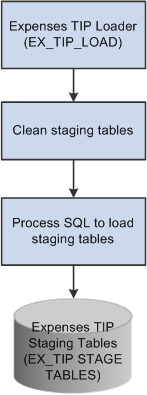
To view PeopleSoft Expenses TIP pagelets, you must add a TIP stage type for each of the 6 expense reports and time reports. Select Travel and Expenses, Real-Time Analysis, Review Transaction in Progress and click the Add a New Value link. Click the Look up icon to obtain the search results. After selecting a TIP stage type, you can specify your search criteria defaults in the Transactions in Progress - Expenses (Details) page.
TIP stage types for PeopleSoft Expenses are:
EXESTNE
EXRECNA
EXAPRNP
TEESTNE
TERECNA
TAUTNE
This example illustrates the fields and controls on the Look Up Transactions in Progress search page.

Choose a TIP link, click the Add button, and select the link again from the search results to go to the (Details) Page and specify your default search criteria.
Note: Although there are 23 TIP stages listed; only 6 belong to PeopleSoft Expenses. If you select a PeopleSoft Project Costing TIP stage, the Project Costing TIP inquiry page appears.
Use the Transactions in Progress - Expenses (Details) page (EX_TIP) to add transactions in progress, specify criteria, and click Search to display a list of expense and time report transactions in progress.
Navigation:
This example illustrates the fields and controls on the Transactions in Progress - Expenses (Details) page (1 of 2). You can find definitions for the fields and controls later on this page.
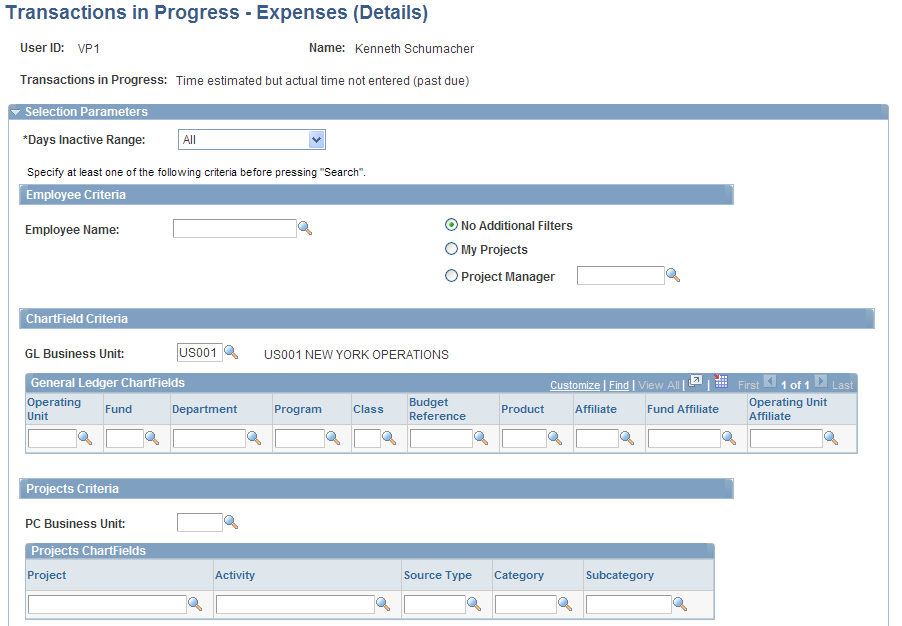
This example illustrates the fields and controls on the Transactions in Progress - Expenses (Details) page (2 of 2). You can find definitions for the fields and controls later on this page.

This page uses fields that are common to other pages discussed in this topic. Refer to the beginning of the topic to review descriptions of these common elements.
You must specify at least one of the following fields in order to process your search: GL Business Unit, Project Costing Business Unit, My Projects, Project Manager, or Employee Name.
Field or Control |
Description |
|---|---|
Days Inactive Range |
Displays the number of days since the last activity. Select 31 to 60, 61 to 90, <31, >90, or All. PeopleSoft Expenses calculates days inactive using the:
Enter the remaining search criteria to filter transactions in progress. Click the Search button for PeopleSoft Expenses to retrieve and display a list of transactions in progress. Note: PeopleSoft Expenses saves your selection criteria (by User ID and TIP stage) so you do not need to re-enter the criteria each time you access this page. |
Graphical View |
Click to see the Transactions in Progress - Expenses (Graphical) page. This link only appears if there is data in the Transactions grid. |
Report ID |
Click to drill down to the Expense Reports or Time Reports Detail page. Click the Return to TIP Inquiry Page link to return to the TIP Inquiry page. |
Use the Transactions in Progress - Expenses (Graphical) page (EX_TIP2) to display a graphical view of expense and time report transactions in progress.
Navigation:
This example illustrates the fields and controls on the Transactions in Progress - Expenses (Graphical) page (1 of 2). You can find definitions for the fields and controls later on this page.
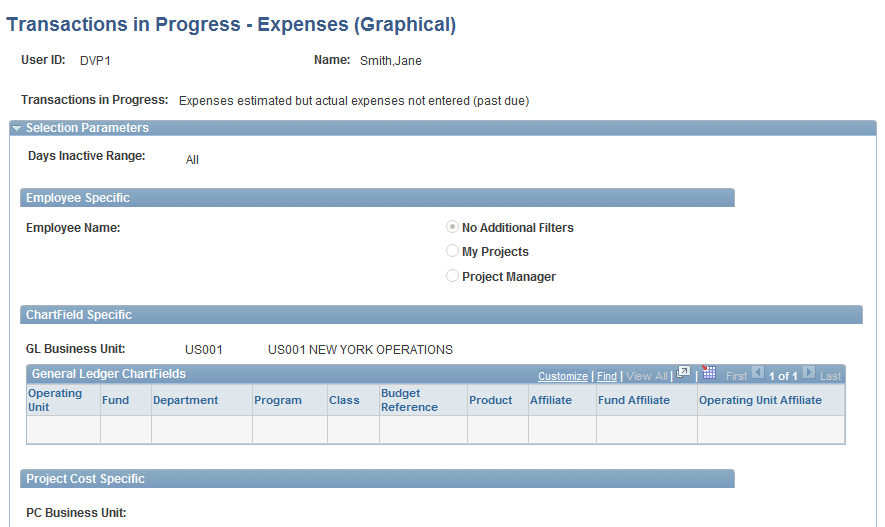
This example illustrates the fields and controls on the Transactions in Progress - Expenses (Graphical) page (2 of 2). You can find definitions for the fields and controls later on this page.
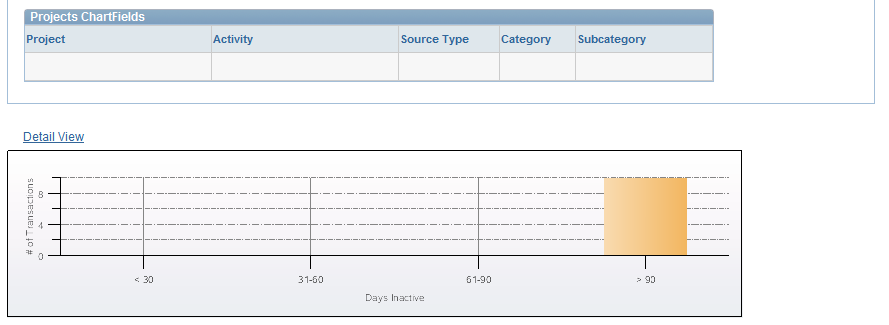
This page uses fields that are common to other pages discussed in this topic. Refer to the beginning of the topic to review descriptions of these common elements.
Expand Selection Parameters to display the filtering options that were used to select the transactions in progress for the chart. Note that those parameters are now read-only.
Click the Detail View link to go back to the Transactions in Progress - Expenses (Details) page.
Use the Personalize TIP for Expense Reports page (EX_PE_TIP_PRS) to define default display information for TIP pagelets for expense reports.
Navigation:
Click the Customize icon on a TIP pagelet for expense reports.
To access the administrator pages, go to
This example illustrates the fields and controls on the Personalize TIP for Expense Reports page (1 of 2). You can find definitions for the fields and controls later on this page.

This example illustrates the fields and controls on the Personalize TIP for Expense Reports page (2 of 2). You can find definitions for the fields and controls later on this page.
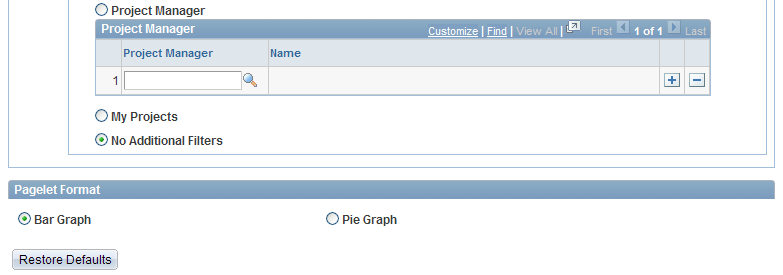
This page uses fields that are common to other pages discussed in this topic. Refer to the beginning of the topic to review descriptions of these common elements.
This page automatically populates with defaults provided from the system administrator personalization page. The parameters specified on this page filter and define the default data that PeopleSoft Expenses displays on a TIP pagelet.
Field or Control |
Description |
|---|---|
Bar Graph |
Select to view search results as a bar graph. |
Field or Control |
Description |
|---|---|
Pie Graph |
Select to view search results as a pie graph. |
Note: The administrator sets the defaults for displaying TIP pagelets as a Bar Graph or a Pie Graph.
If a user personalizes a time report pagelet and changes the default selection for Bar Graph or Pie Graph, the two time report pagelets will be displayed the same way. That is, both time report pagelets can be displayed either as a bar graph or as a pie graph, not one of each.
Similarly, if a user personalizes an expense report pagelet and changes the default selection for Bar Graph or Pie Graph, the three expense report pagelets will be displayed the same way. That is, the three expense report pagelets can only be displayed either as a bar graph or as a pie graph, not one of each.
Use the Administer TIP for Expense Reports or the Administer TIP for Time Reports page to obtain data for PeopleSoft Expenses and Time pagelets .
To obtain data for PeopleSoft Expenses pagelets, an administrator must define filter criteria and then run the Expenses Pagelet Processing process. This process converts expense data to various currencies so that the Total Expense Costs Operational Threshold Alert (OTA) and Transactions in Progress pagelets can provide data in a currency that is meaningful to each user and render data more rapidly. This process is scheduled by navigating to Travel and Expenses, Real-Time Analysis, Update Expenses Pagelet Info.
The administration and processing functionality is the same for Expense Report pagelets and for Time Report pagelets.
This example illustrates the fields and controls on the Administer TIP for Expense Reports page. You can find definitions for the fields and controls later on this page.

This example illustrates the fields and controls on the Administer TIP for Time Reports page. You can find definitions for the fields and controls later on this page.
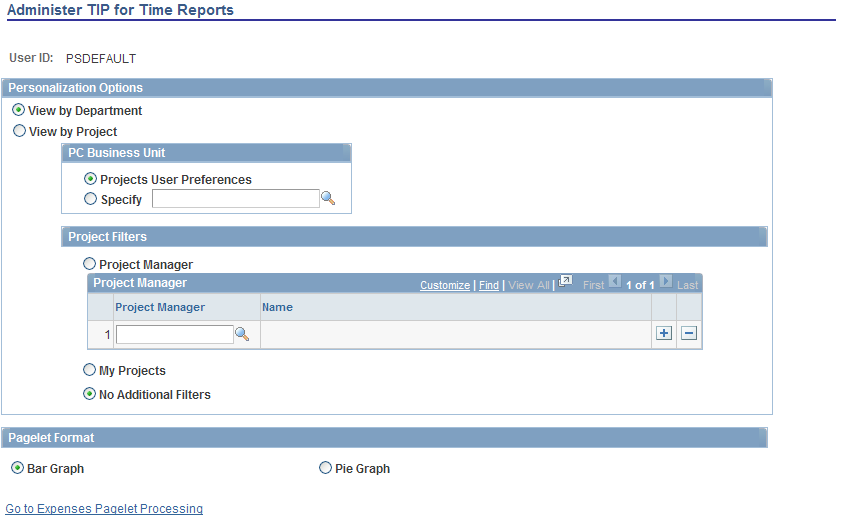
This page uses fields that are common to other pages discussed in this topic. Refer to the beginning of the topic to review descriptions of these common elements.
Note: In the Administer TIP for Time Reports page, users will only see the View by Project and No Additional Filters options.
Field or Control |
Description |
|---|---|
Go to Expenses Pagelet Processing (Travel and Expenses, Real-Time Analysis, Update Expenses Pagelet Info, Expenses Pagelet Processing) |
Click to run the process that populates the tables that enable you to view transactions in progress data and pagelets. When you run Expenses Transaction in Progress Loader application engine (EX_TIP_LOAD), you can run a batch process to load a large amount of transactions in progress data from PeopleSoft Expenses. This decreases the amount of time it takes to load the transactions in progress from the feeder systems to the TIP staging tables and display them in the Project Costing Transaction in Progress page. |
Use the Expenses Pagelet Processing page (RUN_EX_PORTAL_AE) to run the Expenses Pagelet Processing process to convert expense data to various currencies and summarize the information.
Navigation:
Click the Go to Expenses Pagelet Processing link on the Administer TIP for Time Reports page.
Click the Go to Expenses Pagelet Processing link on the Administer TIP for Expense Reports page.
The Expenses Transaction in Progress Loader application engine (EX_TIP_LOAD) enables you to run a batch process to load a large amount of transactions in progress data from PeopleSoft Expenses in order to decrease the amount of time it takes to load the transactions in progress from the feeder systems to the TIP staging tables and display them in the Project Costing Transaction in Progress page.